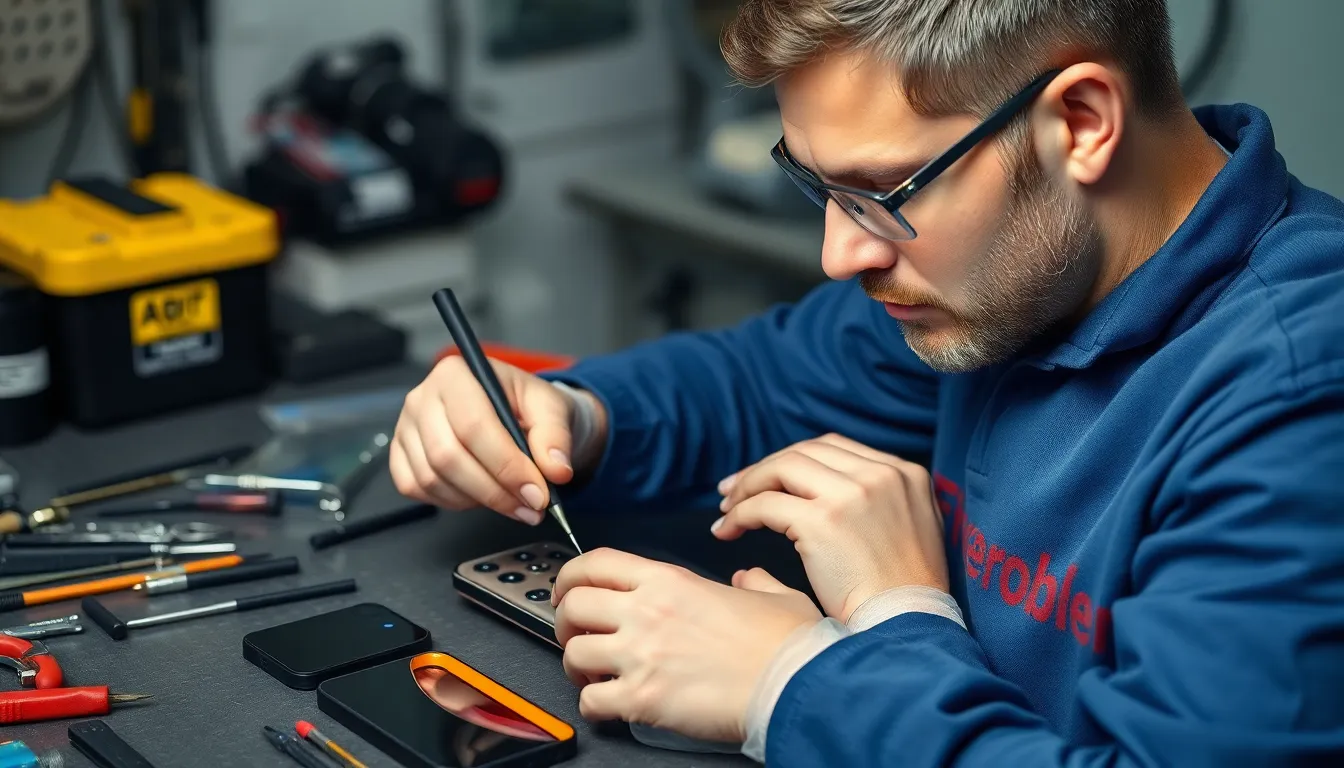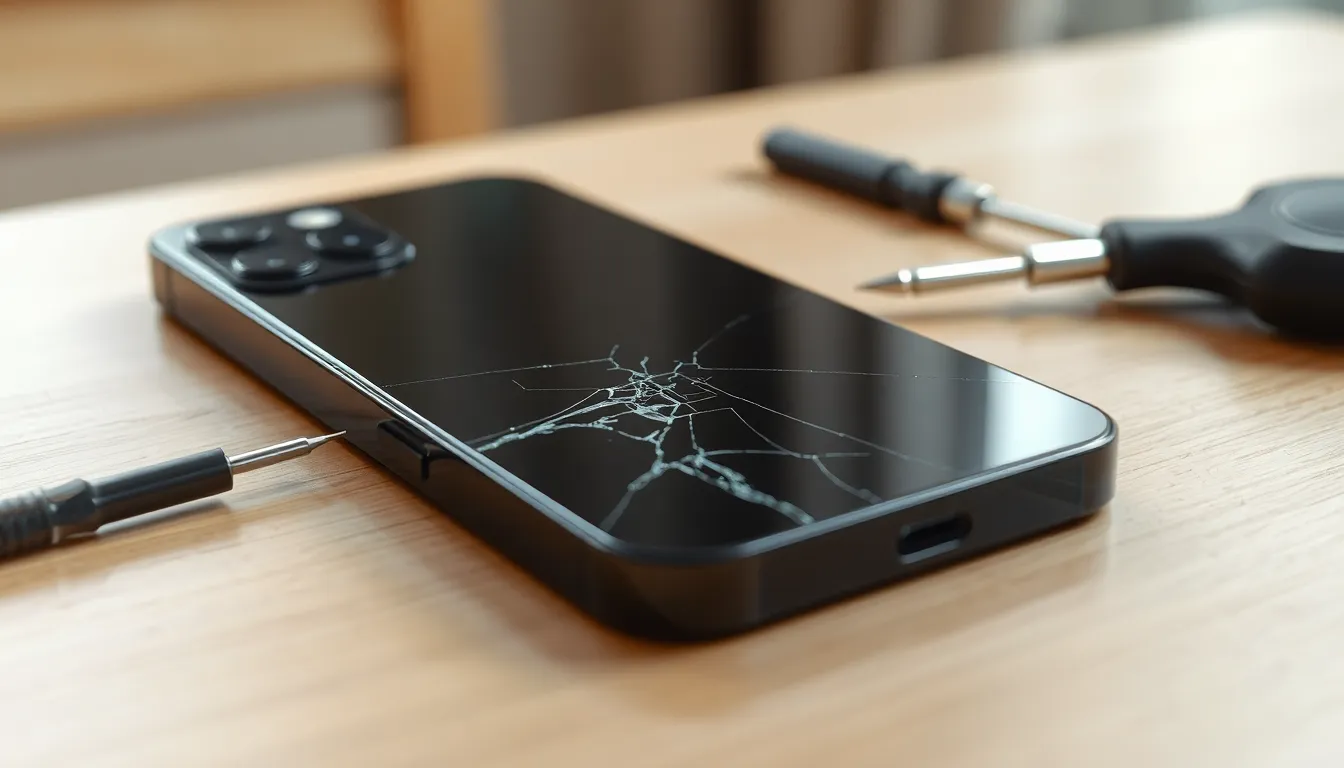Table of Contents
ToggleAccidents happen, and when they do, the back glass of an iPhone 13 Pro Max can end up looking like it survived a battle with a ninja. Whether it slipped from your grip or took a tumble off the coffee table, a cracked back glass can be more than just a cosmetic issue—it can affect functionality and resale value.
Overview of iPhone 13 Pro Max Back Glass
The back glass of the iPhone 13 Pro Max features high-quality materials designed for durability. Cracks in this glass can affect aesthetics and usability. Users might notice that a damaged back glass interferes with wireless charging capabilities, which rely on the integrity of the glass surface.
Repairs often involve replacements at certified service centers. Costs for professional replacement typically range from $200 to $500, depending on factors such as warranty status and location. Third-party repair options may be less expensive, but choosing reputable providers ensures quality.
Transparency around repair processes is essential. Technicians usually replace the entire glass panel rather than simply patching cracks, as this approach guarantees structural integrity. An improper repair can lead to issues like moisture infiltration, impacting internal components.
Potential delays in repair may arise from spare part availability. If users opt for DIY repairs, they should consider necessary tools and skills. Replacement kits are available online, but following instructional videos is crucial for success.
Preventive measures help minimize back glass damage. Using protective cases can absorb impacts during accidental drops. Additionally, applying screen protectors on the front may contribute to overall device longevity.
Regular maintenance practices also enhance device resilience. Keeping the phone away from rough surfaces reduces wear and tear. It’s important to handle the device with care, especially in high-risk environments.
Investing in protective accessories often pays off by extending the lifespan of the device. Users who prioritize maintenance and protection can significantly reduce the likelihood of needing future replacements.
Factors Affecting Replacement Costs

Replacement costs for the back glass of an iPhone 13 Pro Max vary based on several factors. These include labor and parts costs, which significantly influence the total expense.
Labor Costs
Labor costs typically depend on the repair facility’s location and reputation. Skilled technicians often charge more due to their expertise. In general, prices range from $50 to $150 per hour. If a repair shop is certified by Apple, fees might be on the higher end. Some locations may offer lower rates, but compromising on quality can lead to future issues. Consulting with multiple repair shops helps customers find a balance between cost and quality.
Parts Costs
Parts costs play a crucial role in the overall replacement expense. Original equipment manufacturer (OEM) parts can range from $150 to $300. While third-party parts may be more affordable, their quality may vary significantly. Opting for lower-quality parts can increase the risk of further damage. Customers should therefore prioritize OEM parts for better durability and compatibility. Checking multiple suppliers ensures access to competitive pricing, influencing the overall repair budget.
Comparison of Repair Options
Several options exist for replacing the back glass on an iPhone 13 Pro Max. Users can choose between official Apple repairs, third-party shops, or DIY kits, each option having its own pros and cons.
Official Apple Store
Using the official Apple Store for repairs ensures high-quality service and original equipment manufacturer (OEM) parts. The cost usually ranges from $200 to $500, reflecting the expertise and reliability offered. Repairs conducted by Apple technicians come with a warranty, providing peace of mind for users. Additionally, consumers benefit from having their device assessed for other issues during the repair process.
Third-Party Repair Shops
Third-party repair shops often present a more budget-friendly alternative. Prices at these establishments can fluctuate between $150 and $300, depending on location and technician expertise. While many reputable shops offer quality parts, users should verify part quality before proceeding. Important factors include warranty and service guarantees provided, which may vary significantly across different repair locations.
DIY Repair Kits
DIY repair kits allow users to attempt back glass replacement themselves, potentially saving on labor costs. Kits generally range from $50 to $150, including tools and instructions. However, extensive care is required when handling delicate components to avoid further damage. Users must weigh the risk of improper installation against the savings, knowing that any errors could lead to additional costs down the line.
Average Cost Breakdown
Replacement of the back glass on an iPhone 13 Pro Max typically incurs several costs, including parts and labor. OEM parts usually range from $150 to $300, and users often benefit from their reliability and compatibility. Certified Apple repair shops generally charge more, reflecting their quality of service, while third-party shops may offer more competitive rates.
Labor costs vary widely. Rates generally fall between $50 and $150 per hour, depending on the shop’s location and reputation. It’s crucial to factor in these differences when selecting a repair option. Customers may find that authorized facilities provide higher assurance through warranty coverage.
Some users prefer DIY approaches. Repair kits, priced between $50 and $150, present a more cost-effective solution but require technical skill. Attempting a DIY replacement may save money, but risks include potential further damage.
When opting for third-party repairs, verifying part quality is essential. Not all third-party options guarantee the same durability or performance as OEM counterparts. Customers should prioritize service providers who offer quality assessments and warranties.
Ultimately, the total expenses for back glass replacement can fall between $200 and $500 at official Apple stores, while third-party shop replacements range from $150 to $300. Weighing costs against the assurance of service quality can guide users toward the best choice for their iPhone 13 Pro Max.
Tips for Saving on Repairs
Choosing the right repair option can significantly reduce costs. Compare prices among different facilities to find more budget-friendly options. Research experiences of previous customers to identify reputable third-party shops; they often charge between $150 and $300, which is lower than official Apple repairs.
Opting for OEM parts is advisable for reliability and compatibility. While they might be pricier, typically ranging from $150 to $300, their durability can prevent further damage. Many users overlook warranty coverage that comes with Apple repairs, so consider that when weighing overall costs.
Using protective cases can protect the device and reduce the likelihood of needing repairs. Regular maintenance, such as keeping the iPhone away from rough surfaces, can prolong the lifespan of the back glass. By practicing caution, users might avoid significant repair expenses in the future.
Exploring DIY repair kits might seem tempting. Prices for these kits usually range from $50 to $150, making them the cheapest option. However, technical skill is necessary to avoid causing additional damage, leading to higher costs later on.
Consulting multiple suppliers may uncover competitive pricing that can further decrease repair expenses. Taking time to evaluate all available options ensures informed decisions that align with both budget and quality expectations.
Replacing the back glass on an iPhone 13 Pro Max can be a significant investment. Users need to consider various factors such as the quality of parts and the reputation of repair shops. While official Apple repairs ensure high standards and warranty coverage, third-party options can offer cost savings if chosen wisely.
DIY repairs may seem appealing for budget-conscious users but carry risks that could lead to further damage. Ultimately, weighing the cost against the quality of service is essential for making the best decision. By investing in protective accessories and maintaining the device, users can help extend its lifespan and minimize the chances of future repairs.





